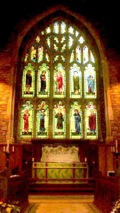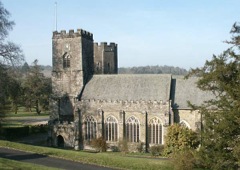

The church of St Germanus in the village of St Germans in south-east Cornwall is one of the finest, oldest and historic parish churches in the county, and one of the oldest buildings still in use for its original purpose. Set within an Area of Outstanding Natural Beauty and at the heart of the St Germans Conservation Area, the church is of exceptional architectural, art historical, archaeological and historic significance which is reflected in its Grade 1* Listing.
An earlier building on the site
was the cathedral for Cornwall between 926 and 1030, before
the area was absorbed into the Diocese of Exeter just before
the Norman Conquest. The Normans then built a Priory on the
site of the old cathedral, and the present church building
dates to the 13th century
and has more original Norman masonry in its powerful and
iconic west front than any other Cornish church; indeed it
is one of the most significant Norman doors in England.
The monks lived on the site of the adjacent house of Port
Eliot, which still has visible monastic 12th-century
walls with lancet windows in the basement, though the rest
of the monastic buildings were changed in the late 18th century.
The Bishop sometimes stayed in a magnificent house at Cudden
beake in the village. The monastery had a busy port and was
an important attraction for pilgrims visiting St Germanus’
relics. The last Prior, Robert Swymmer, surrendered the
Priory in 1539 and it was leased from the Crown by John
Champnon in 1540 after the Kings agents had stripped
everything of value, later passing to the Eliot family, who
still live there today.
St Germanus of Auxerre visited
Britain in 429 AD. We do not have evidence that he visited
the village, but the church and village were associated with
him by the 10th century.